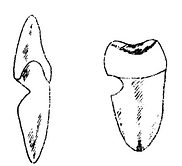| disease | Wedge-shaped Defect |
| alias | Wedge-shaped Defect, Brushing Wear, Wedge-shaped Defect |
Wedge-shaped defect is a loss of hard tissue at the cervical area of the labial or buccal surface of teeth, which occurs gradually and is named for its typical wedge shape.
bubble_chart Etiology
1. Brushing Teeth This is the main cause of wedge-shaped defects, which is why some people refer to wedge-shaped defects as toothbrush abrasion. The reasons are:
① People who do not brush their teeth rarely develop typical wedge-shaped defects, whereas those who brush their teeth, especially those who brush horizontally with force, often exhibit typical and severe wedge-shaped defects.
② It does not occur on the lingual surface of the teeth.
③ Teeth with labial displacement often show more severe wedge-shaped defects.
④ Teeth with wedge-shaped defects are often accompanied by gingival recession.
Experimental evidence also shows that horizontal brushing alone can cause defects at the cervical area of the teeth.
2. Structure of the Tooth Neck The structure at the cementoenamel junction in the cervical area of the tooth is relatively weak and prone to wear, facilitating the occurrence of defects.
3. Role of Acid Acidic exudates in the gingival sulcus are associated with defects. Clinically, defects in the hard tissues beneath the gingival margin are sometimes observed, which suggests this relationship.
4. Fatigue of Tooth Material Recent studies indicate that the buccal cervical area is a stress concentration zone for occlusal forces. Long-term chewing forces cause fatigue in the tooth material, leading to damage in the stress concentration zone.
bubble_chart Clinical Manifestations
1. Typical wedge-shaped defects are formed by the intersection of two planes, some are composed of three planes (Figure 1), and a few defects are oval in shape. The edges of the defects are neat, the surface is hard and smooth, and the color is generally the natural shade of tooth tissue, sometimes with varying degrees of staining.

Figure 1 Wedge-shaped defect (lateral view)
2. According to the degree of defect, it can be divided into three types: shallow, deep, and pulp-penetrating. Shallow and deep types may be asymptomatic or may cause dentin hypersensitivity. The depth and symptoms are not necessarily proportional, with individual differences being the key factor. The pulp-penetrating type presents with symptoms of pulp disease or periapical disease, and may even lead to tooth fracture.
3. It commonly occurs in , especially the first premolars, which are located at the most prominent part of the dental arch and subjected to greater force and more frequent brushing, often accompanied by gingival recession.
4. With increasing age, wedge-shaped defects tend to become more prevalent, and the severity of the defects worsens with age.
bubble_chart Treatment Measures
1. No special treatment is needed for minor tissue defects without dentin hypersensitivity.
2. For cases with dentin hypersensitivity, desensitization therapy should be applied.
3. Larger defects can be treated with filling methods, using glass ionomer cement or composite resin for restoration; for deep cavities or cases with sensitivity symptoms, a base should be applied before filling.
4. If there is pulp infection or periapical disease, pulp therapy or root canal treatment can be performed.
5. If the defect has led to horizontal fracture of the tooth, root canal treatment followed by overdenture or extraction can be considered based on the condition and circumstances. {|104|}
Correct your brushing method, avoid horizontal brushing, and choose a softer toothbrush and finer toothpaste.




